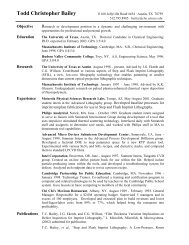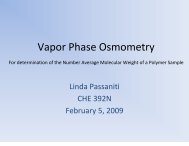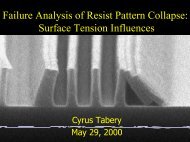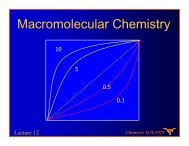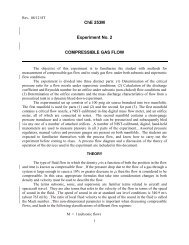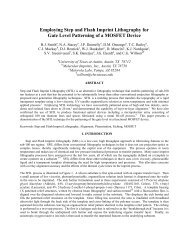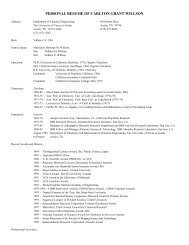Rayleigh Instability of an Annulus
Rayleigh Instability of an Annulus
Rayleigh Instability of an Annulus
You also want an ePaper? Increase the reach of your titles
YUMPU automatically turns print PDFs into web optimized ePapers that Google loves.
Introduction<br />
A slow-moving, thin cylindrical stream <strong>of</strong> water will become non-uniform in<br />
diameter <strong>an</strong>d eventually break-up into droplets. This is <strong>an</strong> example <strong>of</strong> capillary break-up<br />
<strong>an</strong>d commonly known as <strong>Rayleigh</strong> instability. For a cylindrical jet, Lord <strong>Rayleigh</strong><br />
calculated that the most unstable disturb<strong>an</strong>ce wavelength is about nine times the radius <strong>of</strong><br />
the jet. This “most d<strong>an</strong>gerous mode” (λ = 9.016*r) has been proven experimentally <strong>an</strong>d<br />
c<strong>an</strong> be derived via linear stability <strong>an</strong>alysis.<br />
The purpose <strong>of</strong> this project was to predict the most unstable disturb<strong>an</strong>ce<br />
wavelength for liquid jet <strong>of</strong> varying <strong>an</strong>nular geometry (0 < κ < 1).<br />
κa 0<br />
a 0<br />
Surface Energy Argument<br />
Figure 1. <strong>Annulus</strong> with outer diameter a 0<br />
A disturb<strong>an</strong>ce will grow only if the process is energetically favorable. The<br />
surface energy argument says that if a disturb<strong>an</strong>ce increases the surface energy <strong>of</strong> the<br />
system, that disturb<strong>an</strong>ce will decay due to restoring forces (viscosity), which will bring<br />
the system to its lowest energy state. Figure 1 shows the cross section <strong>of</strong> the unperturbed<br />
<strong>an</strong>nulus with outer radius, a 0 . Figure 2 shows the lengthwise view <strong>of</strong> the jet <strong>of</strong> const<strong>an</strong>t<br />
thickness with a sinusoidal disturb<strong>an</strong>ce.<br />
a(1+Asin(2πx/L))<br />
a(1+Asin(2πx/L)) - (1-κ)a 0<br />
a 0 (1-κ)<br />
Figure 2. Lengthwise view <strong>of</strong> disturbed system<br />
For <strong>an</strong> inviscid, one-dimensional <strong>an</strong>nular jet, the surface energy argument utilizes<br />
the following equation to establish a relationship between a <strong>an</strong>d a 0 (see figure 2 for<br />
definition <strong>of</strong> a <strong>an</strong>d a 0 ). V is the volume <strong>of</strong> the fluid, x is the axial dist<strong>an</strong>ce, L is the<br />
2



